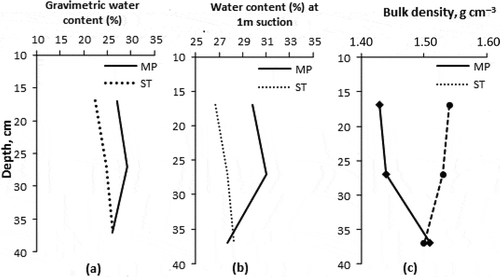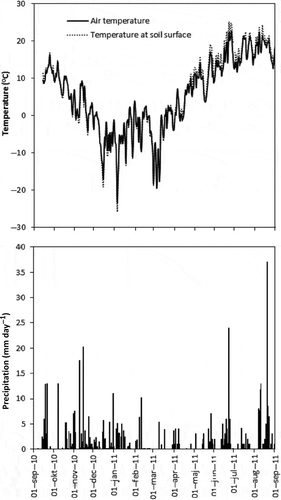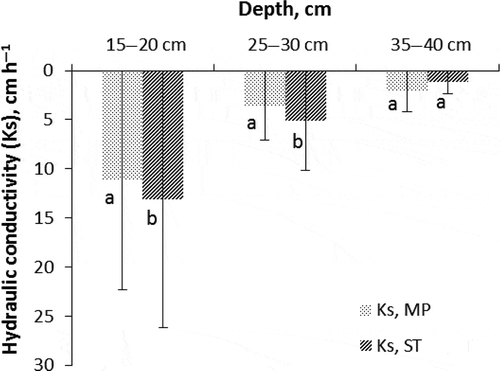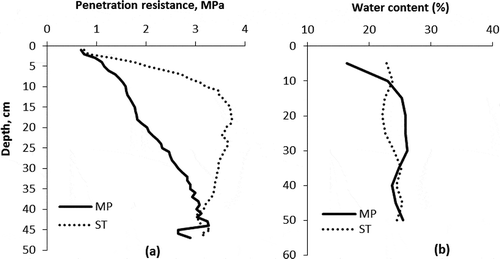Abstract
This study was conducted in spring 2011 in a long-term field experiment with the objective of assessing the effect of shallow tillage (ST) and mouldboard ploughing (MP) on important soil physical properties and crop performance. Undisturbed soil samples were taken before sowing from depths of 15–20, 25–30 and 35–40 cm for the determination of saturated hydraulic conductivity (Ks), bulk density (Bd), and water retention capacity in laboratory conditions. Penetrometer resistance (PR) was measured in the field after 1 month of sowing. Plant density of barley (Hordeum vulgare) was also counted after 1 month of sowing. Field water content was significantly higher for MP than ST at 15–20 cm (MP = 27%, ST = 22.5%) and 25–30 cm depth (MP = 29.3%, ST = 24.8). Water retention at 1 m suction was also significantly higher in the treatment with MP at the depth of 25–30 cm (31%) than in the ST treatment (27.7%). Significantly higher Ks value was found for ST at depths of 15–20 (13.09 cm h−1) and 25–30 cm (5.10 cm h−1) than for MP (11.15 and 3.52 cm h−1, respectively). Soil Bd was significantly lower in MP treatments for the first two investigated depths (1.43 and 1.44 g cm−3, respectively) than in the ST (1.54 and 1.53 g cm−3). Significant higher PR value was found for ST, especially at the depth of 5–35 cm, but the result was not so high as to reduce the root growth. Water content determined parallel with PR measurement was not significantly different for the two treatments. Plant density as well as crop yield in the ST treatment was higher (3840 kg ha−1) than in the MP treatment (2490 kg ha−1). Therefore, we concluded that long-term ST treatment markedly influenced crop performance and yield by facilitating soil physical properties.
INTRODUCTION
Water availability in soil is vital for nutrient solubility and translocations within the soil and soil-plant systems and very much depends on soil physical properties. Tillage practices change soil physical properties to the depth of loosening (Erbach et al. Citation1992) and influence soil moisture characteristics (Coote and Malcolm-McGovern Citation1989).
Different tillage systems loosen soils at different depths and change soil physical properties at different scales (Hamza and Anderson Citation2005; Strudley et al. Citation2008). Mouldboard plough (MP) loosens soils at a greater depth than shallow tillage, resulting in lower soil bulk density (Bd) and higher saturated hydraulic conductivity (Ks) in the upper soil layer than in shallow tillage (ST) or no till systems. For example, Tebrugge and During (Citation1999) measured higher Bd for 4–8 cm and 20–24 cm soil layers under the no till system (1.37 and 1.48 g cm−3, respectively) than under MP (1.17 and 1.29 g cm−3, respectively). Jabro et al. (Citation2010) measured higher Bd (1.57 g cm−3) and lower Ks (30.4 mm h−1) from a field that received shallow tillage (0–10 am depth) than from the deep plough field (0–20 cm depth).
However, as tillage homogenizes surface soil and crop roots grow beyond the ploughed layers, assessment of subsoil physical properties can identify whether there are any subsoil constraints for optimum crop yield. For example, subsoil compaction by tillage and other land management practices may result in an increase of Bd and PR and a reduction of Ks, and these effects are quite persistent, causing significant yield reduction of different crops (Arvidsson Citation2001). Currently, most studies are focused on topsoil physical properties and little is known about the subsoil, especially for Nordic (or temperate climate) conditions. Therefore, the objectives of this study were to evaluate the influences of long-term ST and MP on subsoil physical properties (i.e., Ks, Bd, PR and water retention) and crop performance. We hypothesized that, among the investigated parameters, ST might have higher bulk density than MP only in the upper sub-soil, but ST has a positive effect on other soil physical properties that could facilitate better crop development and higher yield.
MATERIALS AND METHODS
Site description and sample collection
Soil sampling was carried out in the spring (April–May) of 2011 at the Ultuna long-term field experiment site. Since 1974, this experimental site has been managed and monitored by the Swedish University of Agricultural Sciences, Uppsala, Sweden. The soil at the site is classified as Cambisol (Eutric) and has 42–50% clay content. Five different treatments were included in the experiment but this investigation considered only two treatments, ST (tilled to 10–12 cm) and MP (ploughed to 22–24 cm). Each of the treatments has four replicates which were distributed to the site in a randomized block design. Soil organic carbon content in MP at 0–20 cm depth is 19 g kg−1, whereas in the ST system it is 26 g kg−1 at 0–10 cm depth and 19 g kg−1 at 12–17 cm depth (Etana et al. Citation2009).
However, surface soil (0–15 cm) was not considered for investigation as no differences were expected in soil hydraulic properties and dry bulk density since both tillage systems (ST and MP) disturb and mix the soil in this layer. Therefore, samples were collected in three layers (15–20, 25–30, 35–40 cm) from both treatments. In the 15–25 cm layer of the ST system, the soil has not been disturbed over the last 35 years, while it has in the MP system. The measurement at 25–30 cm was to investigate if there were plow pans in one or both of the tillage systems. The measurement at 35–40 cm was to check if there was a difference in subsoil compaction between the treatments.
Three soil cores were taken at each depth. The sampling cores were 5 cm in height with a cross-sectional area of 40.715 cm2. The field was tilled in autumn and barley (Hordeum vulgare) seeds were sown in spring. Samples were collected before sowing of seeds.
Saturated hydraulic conductivity (Ks)
Saturated hydraulic conductivity was measured on the core samples by the constant head method (Andersson Citation1955). Before the measurement, core samples were saturated with water for 3 d. Measurements of Ks were done twice and there was an 8-h interval between the measurements. Darcy’s equation for saturated flow was used to calculate the Ks. Core samples were weighed before saturation in water in order to determine the soil water content at sampling.
Water content at 1 m suction and bulk density
Water retention at the 1 m water column was determined in an Eijkelkamp sandbox which was equipped with a suction leveling stand and filter cloth (140–150 µm) over the sand bed. The saturated soil core samples used for measuring Ks were placed on the filter cloth surface and equilibrium was attained in 1 week. After 1 week, samples were weighed and water content and dry Bd were determined after drying the samples at 105°C for 3 d.
Penetration resistance (PR)
Penetration resistance (PR) was measured 1 month after sowing using an Eijkelkamp hand-held electronic cone penetrometer (Royal Eijkelkamp Company, Netherland). The penetrometer was pushed vertically into the soil profile at a steady speed of 2 cm sec−1. The cone type was 60° angle with 1 cm2 base area. The penetrometer is connected to software that registers the data of cone index along with depth. Ten measurements were done in each plot, giving 80 measurements (2 treatments × 4 replication plots × 10 replication measurements in each plot = 80). The data of PR were recorded to a depth of 48 cm. On the same day soil auger samples were collected at 0–50 cm (every 5 cm) depths from two representative blocks to determine the gravimetric water content by drying the samples at 105°C for 1 d.
Plant density and crop yield
Plants were counted 1 month after sowing within a 50 cm by 50 cm steel frame. Counts were done randomly at four points in each replication of MP and ST and plant density was calculated per square meter. Crop yield data were obtained from long-term yield records (Fältforsk, SLU 2011).
Statistical analysis
T-tests were performed using the statistical software Minitab 16. Paired t-test with 95% confidence interval was done between the treatments for all the parameters investigated. The variables involved in this test were two tillage methods (MP and ST) and different depths (15–20, 25–30 and 35–40 cm).
RESULTS
Soil water content
Soil water content (gravimetric) at sampling (before sowing of seeds in May 2011) is illustrated by , where the water content increased with depth. Soils under MP had significantly (p < 0.001) higher water content at depths of 15–20 cm (27%) and 25–30 cm (29.3%) than ST (22.5% and 24.8%, respectively). No differences were measured between the treatments for the depth of 35–40 cm.
Water content at 1 m suction
Water content at 1-m suction was higher in the samples (sampling before sowing of seeds) taken from MP than in ST () and the water content was significantly (p = 0.03) high for the depth of 25–30 cm (mean value, MP = 31%, ST = 27.7%).
Bulk density (Bd)
shows that the soil Bd was significantly (p < 0.001) higher in ST than in MP for the depth of 15–20 (MP = 1.43 g cm−3, ST = 1.54 g cm−3) and 25–30 cm (MP = 1.44 g cm−3, ST = 1.53 g cm−3), while Bd at 35–40 cm was not different (or the same) between the treatments (1.51 in MP and 1.50 in ST).
Figure 1 (a) Average gravimetric soil water content (%) at sampling in mouldboard ploughing (MP) and shallow tillage (ST); (b) average gravimetric water content of undisturbed samples of MP and ST; (c) average value of soil bulk density in MP and ST in three different layers. N = 4 in (a), (b) and (c).

Saturated hydraulic conductivity (Ks)
In the measured depths, Ks decreased with depth and it was significantly higher (p = 0.01) for ST than MP at a depth of 15–20 cm (MP = 11.15 cm h−1, ST = 13.09 cm h−1) and 25–30 cm (MP = 3.52 cm h−1, ST = 5.10 cm h−1) (). However, there was high variation among the replications of the same treatment. This was probably due to the variation in size and number of macropores and the heterogeneity of the soil, as other researchers also found extremely variable Ks even between samples taken adjacent to each other (Russo and Bresler Citation1981; Lauren et al. Citation1988; Mohanty et al. Citation1994).
Penetration resistance (PR)
The mean value () of PR shows that the PR (performed 1 month after sowing of seeds) was significantly (p < 0.001) lower in MP than in ST at the 5–35 cm depth. Soil samples taken on the same day of PR measurement did not result in any significant difference of soil water content ().
Plant density and crop yield
All replications of ST had higher numbers of plants than MP, and this was in agreement with visual observation. The difference in plant density between the treatments (ST = 310; MP = 229 plant m−2) was highly significant (p < 0.001). Consequently, ST had a higher crop yield (3840 kg ha−1) than MP (2490 kg ha−1) (). On average (1975–2011), the relative crop yield was higher in ST than in MP by 4% ().
Figure 4 Weather data: (a) air temperature (°C) measured from 2 m above the ground and temperature at soil surface (°C) measured from 5 cm above the ground, and (b) precipitation (mm) from Ultuna weather station (published with permission of Ultuna Climate, Department of Crop Production Ecology, SLU, 75007-Uppsala) situated approximately 500 m away from the investigation field.

Table 1 Crop yield data and relative value from 1995–2011 (Faltförsk 2011)
DISCUSSION
Lower Bd in MP at depths of 15–20 cm (1.43 g cm−3) and 25–30 cm (MP = 1.44 g cm−3) than ST (1.54 and 1.53 g cm−3) could be the direct result of soil loosening by the MP which tilled soil down to 24 cm depth (see Materials and methods). On the other hand, ST tilled soil down to 12 cm depth. Any layer just below the plough depth is subject of compaction or plow pan formation (Olesen and Munkholm Citation2007) and results in increasing soil Bd. Increased Bd at the depth of 35–40 cm for MP (1.51 g cm−3) can also be explained by the same mechanisms. Previous experiments in the same field showed reduced Bd and PR due to better soil loosening to the depth of ploughing than ploughless tillage (Arvidsson et al. Citation2012). Wheeling in the furrow during ploughing and the effect of trafficking during secondary tillage and for other operations could be another reason for higher bulk density in the subsoil (Arvidsson Citation2001).
Higher water content (both gravimetric and water content at 1 m suction) for the 15–20 cm and 25–30 cm depths in the MP treatment probably resulted from the larger volume of porosity (or lower Bd) and discontinuity of soil pores. Ploughing loosens the soil and disturbs and/or breaks the biopores, cracks and seals many of the subsoil pore openings and hinders water movement. On the other hand, in ST, biopores or channels created by earthworms below the tillage depth are not destroyed or remain more stable after tillage action that results in higher preferential flow (Cousin et al. Citation2004). In our study, ST possibly also had lower porosity (or high Bd) and better continuity of pores under the tillage depth that resulted in better drainage and lower water content than MP after 1-m suction. This also showed better drainage possibilities in soils under ST than the MP for this investigation site.
Soil water balance (and subsequent crop performance) is often controlled by the Ks of a soil (Ma et al. Citation2009). In ST, biopores and cracks at 15–30 cm are not destroyed by tillage action. Several researchers also found higher Ks in ST than MP where they pointed to the presence of earthworm channels and root channels as the responsible factors (Allmaras et al. Citation1977; Rizvi et al. Citation1987; Cousin et al. Citation2004). On the other hand, ploughing makes the aggregates unstable during wetting (Riley et al. Citation2008; Vakali et al. Citation2011), which could cause lower Ks in MP. In our study, we also found significantly greater Ks in ST (13.09 cm h−1 at 15–20 cm depth and 5.10 cm h−1 at 25–30 cm depth) than in MP (11.15 cm h−1 at 15–20 cm depth and 3.52 cm h−1 at 25–30 cm depth).
Higher penetration resistance reduces root growth (Gregory Citation1994) though the result can vary depending on soil types and crop species. Atwell (Citation1993) wrote that values greater than 2 MPa are considered to be critical, while Greacen et al. (Citation1969) found root growth ceased at a PR of 8 to 5 MPa. As the MP lowers soil bulk density, it also lowers the PR more than in the ST (Khan et al. Citation2001). In ST, the PR was high enough at the 10–20 cm depth to reduce root growth. However, roots can grow at a pressure greater than the penetrometer reading because they can elongate through the biopores and inter-aggregate spaces (Campbell and Henshall Citation1991). Furthermore, values given by penetrometer are usually 2–8 times greater than the resistance value that roots actually get while penetrating the soil (Gregory Citation1994).
In this study, ST had a higher plant density than MP and resulted in a higher yield in the ST treatment (3840 kg ha−1) than the MP treatment (2490 kg ha−1). Several physical factors, especially air, water, soil-seed contact, seedbed characteristics and temperature, are responsible for proper plant establishment. Snow cover in winter 2010–2011 was very thick, resulting in fewer freezing-thawing cycles which could facilitate soil structure regeneration. Such a freezing-thawing cycle might affect the seedbed quality, especially in the MP plots, which were ploughed in autumn 2010. In MP plots, especially in the more moist part of the field, large clods were produced during seedbed preparation. Unfortunately, the seedbed characteristics were not evaluated due to rainfall after sowing. Furthermore, extreme winter following a long dry season (see ) might be another important reason for lower plant density as well as lower crop yield in MP. Several experiments in Nordic countries also reported higher yields of spring cereals under ST than MP, especially when the early summer was dry (Rydberg Citation1987; Børresen Citation1993; Pitkänen Citation1994). They reported that clay soil under ST is better for retaining water during a long dry season. A previous experiment in the same experimental field showed higher organic carbon (26 g kg−1) in ST than MP (19 g kg−1) near the soil surface (Etana et al. Citation2009); that is one of the main reasons to reduce evaporation and retention of moisture in ST during drought.
Although the yield of barley was comparatively lower than other years in ST and MP (see ), stable structure and presence of macropores underneath (below 12 cm) the tilled soils of the ST treatment minimized the negative effect of climate and higher bulk density on crop growth, and resulted in a higher crop yield in ST than MP, because a higher proportion of biopores in ST than MP below the harrowing depth (at 15 cm) favored the root growth (Aura Citation1999).
CONCLUSION
This study reveals that long-term ST and MP treatment at the Ultuna long-term field experiment site has a great effect on sub-soil physical properties and consequent crop yield. Higher hydraulic conductivity and lower water content at the 1 m water column showed better drainage possibilities in ST than MP. The soil’s Bd and PR in the upper investigated layers were higher in ST than in the MP treatment, which were thought to be crop growth-inhibiting factors for the ST treatment; however, the number of seedlings and yield was better in ST than in MP in this investigation. Therefore, we conclude that the changes of subsoil physical properties under the ST treatment are better for crop performance.
REFERENCES
- Allmaras RR, Rickman RW, Ekin LG, Kimball BA 1977: Chiseling influences on soil hydraulic properties. Soil Sci. Soc. Am. J., 41, 796–803.
- Andersson S 1955: Markfysikaliska undersökningar I odlad jord. VIII. En experimentell method. Grundförbättring, 8, 35–44.
- Arvidsson J 2001: Subsoil compaction caused by heavy sugarbeet harvesters in southern Sweden, 1. Soil physical properties and crop yield in six field experiments. Soil Tillage Res., 60, 67–78.
- Arvidsson J, Etana A, Myrbeck Å, Rydberg T 2012: 29 ploughless tillage in long- and short-term experiments. In Sustainable Agriculture, Ed. Jakobsson C, pp. 222–228. Baltic University Press, Uppsala.
- Atwell BJ 1993: Response of roots to mechanical impedance. Environ. Exp. Bot., 33, 27–40.
- Aura E 1999: Effects of shallow tillage on physical properties of clay soil and growth of spring cereals in dry and moist summers in southern Finland. Soil Tillage Res., 50, 169–176.
- Børresen T 1993: Ploughing and rotary cultivation for cereal production in a long- term experiment on a clay soil in southeastern Norway. 2. Yields and weed infestation. Soil Tillage Res., 28, 109–121.
- Campbell DJ, Henshall JK 1991: Bulk density. In Soil Analysis, Physical Methods, Eds. Smith KA, Mullins CE, pp. 329–366. Marcel Dekker, New York.
- Coote DR, Malcolm-McGovern CA 1989: Effect of conventional and no-till corn grown in rotation on three soils in eastern Ontario, Canada. Soil Tillage Res., 14, 67–84.
- Cousin I, Vogel HJ, Nicoullaud B 2004: Influence de la structure du sol `a différentes échelles 20 sur les transferts d’eau: conséquences d’une réduction du travail du sol. Étude Gestion Sols, 11, 69–81.
- Erbach DC, Benjamin JG, Cruse RM, Elamin MA, Mukhtur S, Choi CH 1992: Soil and corn response to tillage with paraplow. Trans. ASAE, 35, 1347–1354.
- Etana A, Rydberg T, Arvidsson J 2009: Readily dispersible clay and particle transport in five Swedish soils under long-term shallow tillage and mouldboard ploughing. Soil Tillage Res., 106, 79–84.
- Fältforsk, SLU 2011: http://www.slu.se/faltforsk (October, 2011)
- Greacen EL, Barleyk P, Farrell DA 1969: The mechanics of root growth in soils with particular reference to the implications for root distribution. In Root Growth, Ed. Whittington WJ, pp. 256–268. Butterworths, London.
- Gregory PJ 1994: Root growth and activity. In Physiology and Determination of Crop Yield, Eds. Boote KJ, Bennett JM, Sinclair TR, Paulsen GM, pp. 65–93. ASA-CSSA-SSSA, Madison, USA.
- Hamza MA, Anderson WK 2005: Soil compaction in cropping systems, a review of the nature, causes, and possible solutions. Soil Tillage Res., 82, 12–145.
- Jabro DJ, Stevens WB, Iversen WM, Evans RG 2010: Tillage depth effects on soil physical properties, sugarbeet yield, and sugarbeet quality. Commun. Soil Sci. Plant Anal., 71, 908–916.
- Khan FH, Tahir AR, Yule IJ 2001: Intrinsic implication of different tillage practices on soil penetration resistance and crop growth. Int. J. Agri. Biol., 3, 23–26.
- Lauren JG, Wagenet RJ, Bouma J, Wiisten JHM 1988: Variability of saturated hydraulic conductivity in a Glossaquic Hapludalf with macropores. Soil Sci., 145, 20–28.
- Ma L, Hoogenboom G, Saseendran SA, Bartling PNS, Ahuja LR, Green TR 2009: Effects of estimating soil hydraulic properties and root growth factor on soil water balance and crop production. Agron. J., 101, 572–583.
- Mohanty BP, Kanwar RS, Ever CJ 1994: Comparison of saturated hydraulic conductivity measurement methods for a glacial-till soil. Soil Sci. Sot. Am. J., 58, 672–677.
- Olesen JE, Munkholm LJ 2007: Subsoil loosening in a crop rotation for organic farming eliminated plough pan with mixed effects on crop yield. Soil Tillage Res., 94, 376–385.
- Pitkänen J 1994: A long-term comparison of ploughing and shallow tillage on the yield of spring cereals in Finland. In Soil Tillage for Crop Production and Protection of the Environment. Proc. 13th Int. Conf. ISTRO, 24–29 July 1994, vol. II, Aalborg, Denmark, Jensen HE, Schjùnning P, Mikkelsen SA, Madsen KBEds, 709–715.
- Riley H, Pommereche R, Eltun R, Hansen S, Korsaeth A 2008: Soil structure, organic matter and earthworm activity in a comparison of cropping systems with contrasting tillage, rotations, fertilizer levels and manure use. Agric. Ecosyst. Environ., 124, 275–284.
- Rizvi HA, Marley SJ, Kanwar RS, Horton R 1987: Field Measurements of Hydraulic Conductivity as Affected by Tillage and Traffic, pp. 97–1554. ASAE, St. Joseph, MI.
- Russo D, Bresler E 1981: Soil hydraulic properties as stochastic processes, I. An analysis of field spatial variability. Soil Sci. Sot. Am. J., 3, 682–687.
- Rydberg T 1987: Studies in ploughless tillage in Sweden 1975–1986, Rapport frän Jordbearbetningsavd, Sver. Lantbruksuniversitet, Uppsala, no. 76, pp 53. (in Swedish, with English abstract).
- Strudley MW, Green TR, Ascough JC 2008: Tillage effects on soil hydraulic properties in space and time. Soil Tillage Res., 99, 4–48.
- Tebrugge F, During RA 1999: Reducing tillage intensity – a review of results from a long-term study in Germany. Soil Tillage Res., 53, 15–28.
- Vakali C, Zaller JG, Köpke U 2011: Reduced tillage effects on soil properties and growth of cereals and associated weeds under organic farming. Soil Tillage Res., 111, 133–141.


